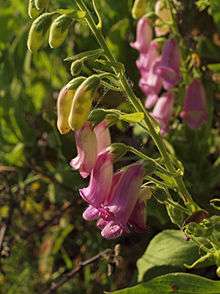Digitalis thapsi
| Digitalis thapsi | |
|---|---|
| | |
| Scientific classification | |
| Kingdom: | Plantae |
| (unranked): | Angiosperms |
| (unranked): | Eudicots |
| (unranked): | Asterids |
| Order: | Lamiales |
| Family: | Plantaginaceae |
| Genus: | Digitalis |
| Species: | D. thapsi |
| Binomial name | |
| Digitalis thapsi L. | |
| Synonyms | |
|
Homotypic:
Heterotypic:
| |
| Wikimedia Commons has media related to Digitalis thapsi. |
| Wikispecies has information related to: Digitalis thapsi |
Digitalis thapsi, known commonly as Spanish foxglove, Spanish digitalis, and fingerhut foxglove, is a flowering plant in the genus Digitalis that is native to Spain.[1] It was first described by Carl Linnaeus in 1753. It is of commercial importance as an ornamental plant. Hybrids with D. purpurea have proved successful and are fertile.
Description

Its yellow-green leaves are ovate to oblong in shape and decurrent, with winged bases. The flowers, stems and leaves are covered with tiny hairs, giving them a soft appearance.[2] The leaves have non-glandular trichomes and a striated cuticle. The pink flowers are arranged in raceme inflorescences.[3]
Chemical properties
In studies, the restriction of calcium ions resulted in cardenolide accumulation in D. thapsi.[4] Calcium quantity affects the redox chemical reactions in the cells. Without calcium, changes in antioxidant function were observed and catalase activity was slow.[5] In another study, lack of calcium retarded growth and promoted digoxin formation. Manganese, in the form of manganese sulfate (MnCl), and lithium, in the form of lithium chloride (LiCl), also increased the digoxin concentration, but did not affect growth.[6]
Calcium oxalate crystals and pericyclic fibers have been isolated from D. thapsi. These are 1.25 to 3 times more powerful in medicinal view than those found in D. purpurea.[2][7][8][9] According to Dutch botanist Herman Boerhaave, Digitalis species are highly poisonous if directly ingested. All parts are poisonous.[3][10][11]
Propagation
Besides normal cultivation, D. thapsi has been propagated using explant culture, a technique employed for the isolation of cells from piece(s) of tissue for harvesting. Auxins NAA, 2,4-D and IAA alone or combined with BA produced a callus. NAA caused root formation and BA shoot formation. NAA and BA combined induced organ generation much effectively. Plantlets obtained this way had a survival rate of 70%.[12]
Joseph Gottlieb Kölreuter, a German botanist, observed that D. thapsi had many characteristics of D. purpurea after four to five generations of cultivation, and that the former became indistinguishable from the latter, a report that was considered "probably" trustworthy by Charles Darwin.[13] D. thapsi and D. purpurea hybrids are generally fertile.[13]
Habitat and growth
D. thapsi is widespread in Spain. A biennial evergreen plant, it flowers in late spring.[3] A study of the fruiting activity in D. thapsi showed that production, size and number of seeds were interrelated. Analysis has shown that seed weight is not related to the length of the cotyledon, and that the length of the fifth leaf can serve as a useful factor in determining the genetic variability among specimens.[14]
Cultivation
The species is used as an ornamental plant.[15] It grows well in half-shaded to sun-exposed areas. Moderate watering is required, and the plant has an average drought tolerance. The soil should have a pH of 5 or up to 8. It can grow in chalk, clay, loam, sand, peat, or combinations.[3]
References
- ↑ Digitalis thapsi. Germplasm Resources Information Network (GRIN).
- 1 2 Kar, A. (2003). Pharmacognosy And Pharmacobiotechnology. New Delhi: New Age International Ltd. p. 173. ISBN 81-224-1501-6.
- 1 2 3 4 "Digitalis thapsi". Plant Database. Retrieved 2 October 2012.
- ↑ Cacho, M. M.; et al. (1995). "Calcium restriction induces cardenolide accumulation in cell suspension cultures of Digitalis thapsi L.". Plant Cell Reports. Germany: Springer Verlag. 14 (12). ISSN 0721-7714.
- ↑ Paranhos, A.; Fernandez-Tarrago, J.; Corchete, P. (1 January 1999). "Relationship between active oxygen species and cardenolide production in cell cultures of Digitalis thapsi: effect of calcium restriction". New Phytologist. 141 (1): 51–60. doi:10.1046/j.1469-8137.1999.00317.x.
- ↑ Corchete, M. P.; et al. (1 October 1991). "Effect of calcium, manganese and lithium on growth and cardenolide content in cell suspension cultures of Digitalis thapsi L.". Plant Cell Reports. 10 (8). doi:10.1007/BF00232609. ISSN 1432-203X.
- ↑ Nirali Prakashan (2009). Pharmacognosy. Nirali Prakashan. pp. 39–40. ISBN 978-81-963961-5-2. Retrieved 31 August 2012.
- ↑ "Digitalis thapsi 'Spanish Peaks'". Missouri Botanical Garden. Retrieved 31 August 2012.
- ↑ Khandewal, K. R. (2008). Practical Pharmacognosy. Pune: Nirali Prakashan. p. 59. ISBN 978-81-85790-30-5.
- ↑ Edinger, Philip; Janet H. Sanchez (2002). Annuals and Perennials. Sunset Books. p. 118.
- ↑ Encyclopedia Britannica (Vol. 4) (6 ed.). Edinburgh: Archibald Constable and Company. 1823.
- ↑ Cacho, Margarita; Margarita Morán; María Teresa Herrera; Jorge Fernández-Tárrago (May 1991). "Morphogenesis in leaf, hypocotyl and root explants of Digitalis thapsi L. cultured in vitro". Plant Cell, Tissue and Organ Culture. 25 (2): 117–23. doi:10.1007/BF00042182.
- 1 2 Stauffer, ed. from manuscript by R. C. (1987). Charles Darwin's Natural selection : being the second part of his big species book written from 1856 to 1858. (1. paperback ed.). Cambridge [u.a.]: Cambridge University Press. p. 127. ISBN 0-521-34807-2.
- ↑ Cabello, M. L.; Ruiz, T.; Devesa, J. A. (2001). "Carpology, germination and seedling performance in Digitalis thapsi L. (Scrophulariaceae)". Botanical Journal of Scotland. 53 (2): 135–154. doi:10.1080/03746600108685019.
- ↑ editor, Chittaranjan Kole, (2011). Wild crop relatives genomic and breeding resources. Berlin: Springer. p. 78. ISBN 978-3-642-21201-7.